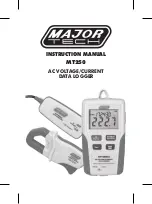
Chapter 1 TriLog
11
2. a) PC serial communication socket: Connect the stereo plug of the serial
communication cable to this socket and the 9-pin plug to the computer
’
s serial
port, usually located at the back of the computer.
Or:
b) PC USB communication socket: Connect the mini USB plug of the USB
communication cable to the TriLog and the USB Type A plug to the computer
’
s
USB port (see page 47 for USB driver installation).
3. External DC power supply socket: Plug in an AC/DC 9 - 12V adaptor whenever
you want to save battery power, or to charge the battery when necessary.
Connecting external power to the TriLog automatically charges the internal
battery. The adaptor should meet the required specifications (see section
1.1.4).
1.1.3. Battery
TriLog is equipped with a 2.4V/850mAh NiMH rechargeable battery. Before you start
working with TriLog for the first time, charge the unit for 10 to 12 hours while it is
turned off.
If the data logger
’
s main battery runs out, the internal 3V Lithium battery backs up
the memory, so no data will be lost.
Note:
Battery shelf charge life is about 100 hours.
To maximize battery
shelf charge life, always disconnect sensors when not in use.
Disconnect TriLog from the computer when not in use. You can
continue to operate TriLog by plugging it into the wall.
1.1.4. AC/DC
Adaptor
•
Output: Capacitor filtered 6 VDC, 500mA.
•
2.5mm stereo plug, tip positive.
1.1.5. Automatic
standby
TriLog switches automatically to standby mode after 5 minutes have passed since
the time of the last data recording, the last button was pressed, or the last
communication was made with the PC.
While on standby, TriLog switches to a low-power state where the electronic circuitry
and the display are turned off and TriLog uses less power.
1.1.6.
Power saving mode
When performing long experiments at low rates, of up to 1 per minute, TriLog
enables you to work in power saving mode. In this mode TriLog switches to standby
mode and
‘
wakes up
’
for brief periods of time only to execute data logging and then
returns to a standby.
This will enable TriLog to work continuously, without recharging the battery, for up to
100 hours instead of 5 hours in normal mode.
To learn how to operate in power saving mode please refer to section 3.5.1.5 on
page 69.












































